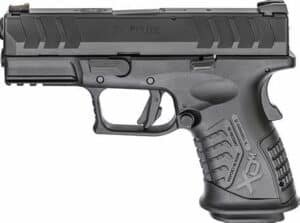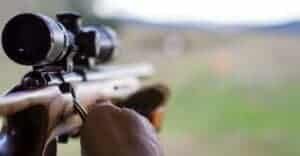Are you looking to find the best bear hunting rifle? How about the best handgun for bear defense? We’re here in the armory to assist you with your search. It doesn’t matter if you’re a seasoned hunter or a beginner.
Bear hunting, a centuries-old tradition steeped in history and adventure, has captivated the imaginations of hunters and outdoor enthusiasts worldwide. The specialized tools known as bear-hunting arms are central to this timeless pursuit.
These arms encompass a range of weaponry carefully selected for their effectiveness in tracking and harvesting bears, ensuring the hunter’s safety and an ethical hunt. This article will explore the fascinating world of bear-hunting arms, exploring their definition, importance, and historical significance.
Definition of Bear Hunting Arms
Bear hunting arms refer to the specific equipment utilized by hunters in pursuit of these formidable creatures. These arms include traditional weapons passed down through generations and modern advancements tailored to meet contemporary hunting needs. From bows and arrows that require immense skill and precision to powerful firearms designed for long-range accuracy, bear hunting arms encompass a diverse array of tools that aid hunters in their quest for a successful hunt.
Traditional Bear Hunting Arms
Traditional archery equipment and firearms have played a significant role in bear hunting throughout history. Archery, in particular, has a rich legacy in bear hunting. Recurve bows, characterized by their elegant curve away from the shooter when unstrung, are popular among traditional archers.
The simplicity of these bows makes them reliable and easy to maintain in the wilderness. Compound bows, on the other hand, have gained immense popularity due to their advanced technology and improved performance.
These bows utilize cams and pulleys to achieve higher arrow speeds with less effort from the archer. In addition to archery equipment, firearms have always been prominent in bear hunting expeditions.
Rifles offer great accuracy and range capabilities for taking down bears efficiently. Many hunters favor bolt-action rifles for their reliability and ability to handle powerful cartridges suitable for big game hunting.
Lever-action rifles also hold a special place in North American bear hunting culture as they were commonly used during historic times when encountering large predators was more frequent. Shotguns also find their utility when it comes to bear hunting.
Pump-action shotguns provide quick follow-up shots if necessary while maintaining decent accuracy at close ranges. Break-action shotguns are also popular due to their simplicity and ruggedness, making them reliable even under harsh wilderness conditions.
Modern Bear Hunting Arms
The modern era has brought technological advancements that have revolutionized bear-hunting arms across both archery and firearms categories. Advanced compound bows with high let-off features allow hunters greater ease while holding at full draw for extended periods without muscle fatigue affecting accuracy or shot placement. Adjustable draw weights accommodate individual hunters’ different skill levels and preferences, making these bows versatile for bear-hunting scenarios.
Specialized rifles, specifically designed to handle the challenges of bear hunting, have also emerged. These rifles are chambered with powerful cartridges that deliver adequate energy and penetration to take down large game-like bears.
With improved ballistic performance and advanced optics, these specialized rifles provide hunters with enhanced accuracy and confidence in their abilities to make clean kills. Shotguns equipped with slug ammunition have gained popularity for close-range encounters during bear hunting expeditions.
Slugs offer increased stopping power at shorter distances, making them reliable tools when faced with aggressive bears in dense thickets or confined spaces. Using shotguns with slug ammunition ensures maximum energy transfer upon impact, increasing the chances of swiftly incapacitating the bear.
Archery Equipment for Bear Hunting
Recurve bows
Recurve bows, known for their elegant simplicity, have been used in bear hunting for centuries. These bows feature limbs that curve away from the archer when unstrung, providing a smooth draw and powerful energy transfer upon release.
The design of recurve bows allows for a longer power stroke, resulting in faster arrow speeds and increased kinetic energy. This can be advantageous when hunting bears, giving the hunter a flatter trajectory and deeper penetration.
However, recurve bows require more strength to draw compared to compound bows, making them less accessible to some hunters. Additionally, their larger size can be cumbersome when navigating through densely forested areas or during long treks.
Compound bows
Compound bows have revolutionized bear hunting due to their superior technology and performance capabilities. These modern marvels employ a system of cams and pulleys to reduce the holding weight at full draw, providing hunters with improved accuracy and reduced fatigue during extended waits for the perfect shot opportunity. The mechanical advantage offered by these components allows archers to achieve high arrow speeds while maintaining control over their shots.
Compound bows also offer adjustable draw lengths and weights, catering to individual preferences and ensuring optimal shooting form for each hunter. With their compact size and maneuverability, compound bows are well-suited for hunting bears in challenging terrains or from tree stands.
Longbows
Longbows hold a significant historical context in bear hunting traditions across various cultures worldwide. These traditional weapons date back thousands of years and were widely used by indigenous communities who hunted bears to survive.
Longbows are characterized by simple construction – a single piece of wood shaped into a bow without any added mechanical components like those found in compound or recurve designs. Despite lacking modern innovations, longbows offer advantages such as smooth shooting and reduced noise, making them an ideal choice for hunters seeking a more traditional experience.
Their long, forgiving limbs allow for a forgiving shooting technique and can suit archers who prefer a slower but highly accurate approach to bear hunting. However, due to their lack of mechanical aids, longbows require significant skill and practice, testing the archer’s ability to maintain consistent form and release.
By understanding the characteristics of each type of archery equipment used in bear hunting – recurve bows, compound bows, and longbows – hunters can make informed decisions when selecting their preferred armament based on personal preferences, physical capabilities, and hunting conditions. Each bow type has unique advantages and limitations that should be considered before embarking on the thrilling endeavor of bear hunting.
Firearms for Bear Hunting
Rifles
Rifles are popular for bear hunting due to their power and accuracy. Three stand out among the rifles used: bolt-action, lever-action, and semi-automatic. Each type offers unique advantages that cater to different hunting preferences and situations.
Bolt-action rifles
Bolt-action rifles are renowned for their reliability and exceptional accuracy, making them a top choice for bear hunters seeking long-distance shots. The bolt action mechanism ensures precise chambering of each round, enhancing the rifle’s functionality in adverse conditions.
Additionally, bolt-action rifles provide excellent safety features such as manual safeties and controlled-feed systems that minimize the risk of misfires or failures to feed. Popular calibers used in bear hunting include .30-06 Springfield, .300 Winchester Magnum, and .338 Lapua Magnum.
Lever-action rifles
Lever-action rifles are special in North American bear hunting culture due to their historical significance. These firearms evoke images of early pioneers and frontiersmen who relied on lever actions during expeditions. Although lever-actions may have limited magazine capacity compared to other rifle types, they compensate with quick follow-up shots facilitated by the smooth lever-operated action.
Lever-actions excel in fast-paced scenarios where maneuverability is crucial while maintaining satisfactory firepower. Popular calibers for bear hunting with lever-action rifles include .45-70 Government and .444 Marlin.
Semi-automatic rifles
Semi-automatic rifles have become increasingly popular among modern hunters due to their rapid-fire capability and user-friendly design. These firearms offer quick follow-up shots without manual manipulation between rounds, increasing chances of success when encountering multiple bears or engaging in intense situations where speed matters most. While semi-automatics are versatile and available in various calibers suitable for bear hunting, it is important to note that specific regulations may apply depending on the region or hunting area.
Conclusion
Selecting the right firearm is crucial for safety and success in bear hunting. Whether opting for a traditional bolt-action rifle with its unmatched reliability and accuracy at long distances, embracing the historical charm of lever-action rifles while compromising on magazine capacity, or harnessing the rapid-fire capabilities offered by semi-automatic rifles, hunters have an array of options to suit their preferences. Regardless of the chosen firearms, responsible hunting practices and adherence to local regulations are paramount.
So go forth confidently armed with your well-chosen rifle, immerse yourself in nature’s challenges, and ensure conservation efforts are upheld. Happy hunting!



